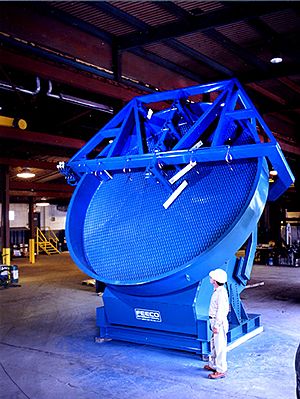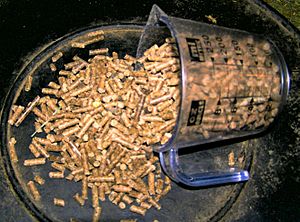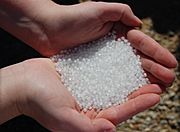Pelletizing facts for kids
Pelletizing is a cool process where different materials are squished or shaped into small, round pieces called pellets. Think of it like making tiny balls out of something! This method is used for lots of things, like chemicals, iron ore, animal food, plastics, and even waste.
Making materials into pellets is a great way to store and move them around easily. This technology is super useful in industries that work with metal powders and in medicine.
Contents
Making Iron Ore Pellets
Iron ore is often turned into pellets because these little balls have excellent qualities for making steel. Iron ore pellets are usually about 6 to 16 millimeters (0.2 to 0.6 inches) wide. They are used as a main ingredient in huge ovens called blast furnaces.
These pellets typically contain 64–72% iron. Other materials like limestone, dolomite, and olivine are added to change their chemical makeup. A material called Bentonite is often used to help bind everything together.
The process of making iron ore pellets involves a few steps:
- First, the raw materials are mixed.
- Then, the pellets are formed into soft, raw balls.
- Finally, these soft pellets are baked in a special oven (a kiln or traveling grate) to make them hard.
When iron ore is in pellet form, air can flow easily between the pellets in a blast furnace. This helps the air move up through the materials during the steel-making process. If the iron ore were just fine powder, it would pack together too tightly and block the airflow. That's why pellets are much better than powder for making steel!
The quality of iron ore pellets depends on many things. These include how small the raw material particles are, how much water is used, the speed of the pellet-making machine, and the type and amount of binder.
Getting Raw Materials Ready
Extra materials are added to the iron ore (called "pellet feed") to make sure the final pellets have the right properties. This mixture goes into a machine called a pelletizer. This machine can mix different types of ores and other additives.
Generally, preparing the raw materials involves these steps:
- Cleaning and separating the materials.
- Mixing the substances evenly.
- Grinding them into a fine powder.
- Sorting them by size.
- Making the mixture thicker.
- Mixing the thick liquid evenly.
- Filtering out any excess water.
Shaping the Raw Pellets
The goal of shaping raw iron ore pellets is to create pellets that are the right size. They also need to be strong enough to handle being moved, transported, and used without breaking. For example, waste materials are ground up before being heated and pressed into pellets. Both mechanical force (squishing) and heat are used to make the pellets just right.
In factories, there are two main types of machines for making iron ore pellets: the drum and the pelletizing disk.
Heating the Pellets
To make the pellets very strong and give them the right qualities for steelmaking, they go through a heating process. This involves several stages:
- Drying them out.
- Preheating them.
- Firing them at high temperatures.
- After-firing (a final heat treatment).
- Cooling them down.
How long each stage lasts and how hot the pellets get really affects how good the final product is.
Pellets in Medicine
In medicine, pelletizing means turning fine powders or tiny grains into small, round pellets. This method has become very popular because it allows medicines to be released slowly and steadily into the body. This helps the medicine be absorbed more evenly and causes less irritation in the stomach.
There are different ways to make pellets in the pharmaceutical industry. These methods often depend on how the particles are made to stick together. Some examples include balling, compression, and spray congealing. The "balling" method is similar to how wet pellets are made in the iron ore industry.
Making Animal Feed Pellets
Animal feed can also be made into pellets. These pellets can be tiny, like 1.2 millimeters (0.05 inches) for shrimp feed. They can also be larger, like 3 to 4 millimeters (0.1 to 0.16 inches) for poultry feed, or even 8 to 10 millimeters (0.3 to 0.4 inches) for larger farm animals. Animal feed pellets are made using a special machine called a pellet mill at a feed mill.
Preparing Animal Feed Ingredients
First, the ingredients for the animal feed are usually ground into smaller pieces using a hammer mill. Then, these ingredients are measured out (batched) and mixed very well by a feed mixer. Once the feed is mixed, it's ready to be turned into pellets.
Shaping the Feed Pellets
The pelletizing happens in a pellet mill. Here, the feed is usually warmed up and treated in special conditioners inside the mill. Then, the feed is pushed through small holes, coming out as finished feed pellets.
Making Wood Pellets
Wood pellets are made by squishing sawdust or other ground-up wood materials. They are used for many things, especially for energy. In power plants, wood pellets are sometimes used instead of coal to create electricity. For example, a large power station in England, Drax, uses wood pellets for most of its energy.
Since wood that is harvested responsibly doesn't cause a long-term increase in carbon dioxide in the air, wood fuels are seen as a low-carbon way to get energy. Wood pellets are also used to heat homes and businesses, either in automatic boilers or special pellet stoves. Compared to other wood fuels, pellets are great because they pack more energy into a smaller space, are easy to handle (they flow like grain), and have low moisture.
Some people have concerns about how wood pellet production affects the environment in the short term, especially if it leads to cutting down old forests that might not otherwise be logged. However, the companies that make pellets and work in the forest industry disagree with these claims.
After Pelleting Wood
After the wood pellets are made, they are cooled down using a cooler. Other steps after pelleting can include further conditioning, sorting them with a screen, and sometimes adding a coating if needed.
Gallery
See also
 In Spanish: Peletización para niños
In Spanish: Peletización para niños
- Blast furnace
- Iron ore
- Nurdle (bead)
- Pellet (disambiguation)
- Pellet mill






